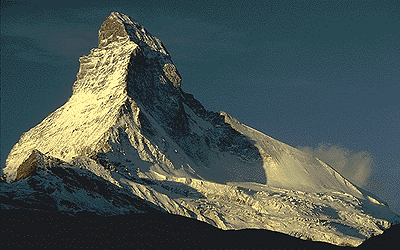An Introduction to Structural Geology and Tectonics
|
An Introduction to Structural Geology and Tectonics |

The surface expression of plate convergence and collision is responsible for perhaps the most visible tectonic phenomenon: mountain belts (Figure). Mountain belts, as well as associated volcanism and (major) earthquakes, form the essence of geology for much of the general public. Many (structural) geologists will likely agree with this perspective. Beside their mere beauty, the underlying processes of mountain formation provide a detailed view of the inner workings of plate interactions and lithospheric evolution, which are the focus of this chapter. In the previous chapter, we examined the process by which continental lithosphere rifts apart, and we noted that an oceanic spreading ridge forms between the once adjacent blocks if rifting is successful. At first, the oceanic lithosphere formed at the ridge is warm, and relatively buoyant. This is the reason that oceanic ridges are, in fact, ridges, and rise to shallower depths than the surrounding abyssal plains. But as the new lithosphere moves away from the ridge axis, it cools, the mantle portion of the lithosphere thickens, and lithospheric density increases. Eventually, oceanic lithosphere actually becomes negatively buoyant; in other words, it becomes denser than the underlying hot asthenosphere. Once oceanic lithosphere has become negatively buoyant, it can subduct, meaning it can sink into the asthenosphere. Exactly how the subduction process initiates remains somewhat of a puzzle, but possibly it begins in response to compression across an existing weakness in the oceanic lithosphere (e.g., a transform fault or the contact between oceanic and continental lithosphere). Compression causes thrusting, which in turn results in insertion of the negatively buoyant oceanic lithosphere into the asthenosphere, and once there, this lithosphere begins to sink, pulling the rest of the oceanic plate with it. With the onset of subduction, a new convergent plate margin develops. At a convergent plate margin, oceanic lithosphere of the downgoing slab (or downgoing plate) bends and descends into the mantle beneath the overriding slab (or overriding plate). A deep, locally sediment-filled trough, the trench, forms at the boundary between the downgoing and overriding slabs, and an accretionary wedge, which is a package of intensely deformed sediment and oceanic basalt, may form at the edge of the overriding slab. The top of the accretionary wedge is buried by undeformed strata of the forearc basin. This basin, which may also bury trapped oceanic lithosphere, lies between the accretionary wedge and a chain of volcanoes known as the volcanic arc. For purposes of directional reference, the region on the trench side of a volcanic arc is the forearc region; the accretionary wedge, forearc basin, and trench are all in the forearc region. The other side of the overriding plate with respect to the arc is the backarc region, where contraction, extension, or strike-slip deformation may occur.
As subduction consumes an oceanic plate, pieces of buoyant lithosphere attached to the downgoing slab may eventually be brought to the convergent boundary. Examples of buoyant lithosphere, include large continents, small continental fragments, island arcs (volcanic arcs built on sea floor), oceanic plateaus (broad regions of anomalously thick oceanic crust) and some spreading ridges. Regardless of type, buoyant lithosphere cannot be subducted, and when it merges with the overriding slab, the boundary becomes a collision zone. Both convergent plate boundaries and collision zones are sites of contractional tectonics, meaning that at these locations, lithosphere shortens in the horizontal direction, and consequently thickens in the vertical direction. Contractional tectonics causes thrust faults, folds, tectonic foliations, metamorphism, and igneous activity. It produces great mountain ranges, like the present-day Himalayas and Andes, and the Paleozoic Appalachians-Caledonides. You will learn, however, that extension and strike-slip may occur coevally with this contraction. In this chapter, we discuss the principal structural and lithologic features formed at convergent boundaries and in collision zones.